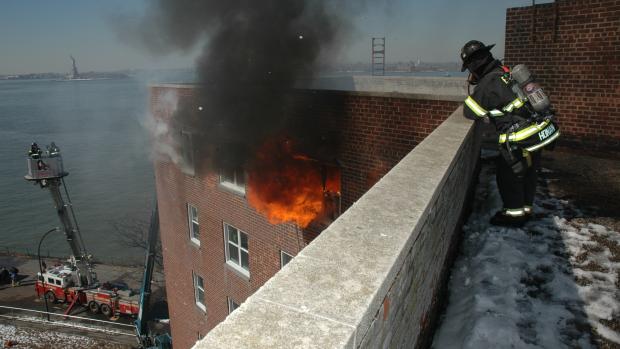Research Leads to New FDNY Firefighting Procedures

As 30 mph winds feeding a fire in a Manhattan high-rise apartment building threatened to create the unpredictable, fast-moving “blowtorch” effect that has killed far too many members of the Fire Department of New York (FDNY), firefighters fought back with new tactics researchers at Polytechnic Institute of NYU helped to develop and implement.
Firefighters positioned on the floor above the fire deployed a fire curtain over the side of the building to cover the window that was letting in the wind. Wind acts as jet fuel in such fires. Firefighters stationed on the floor below the fire fed a specially-designed nozzle — called a high-rise nozzle — into a window on the fire floor to blast water on the flames. And in the stairwells, firefighters rapidly cleared deadly smoke and carbon monoxide from the building with positive pressure ventilation (PPV) fans.
That potentially-fatal fire occurred on November 13, 2009, nearly two years into a project between NYU-Poly, FDNY, and the National Institute of Standards and Technology that has forever changed the way wind-driven high-rise fires are fought in this city, and soon, in cities across the nation. The American Society of Mechanical Engineers featured the project as the cover story in the July 2010 issue of its journal, Mechanical Engineering. In contrast to the decades it can take for many technologies to move from the laboratory into accepted practice, the speed with which the research is changing firefighting is almost unprecedented.
High-rise nozzles, fire curtains, and PPV fans are now among FDNY’s firefighting arsenal, courtesy of a $1 million grant from the Department of Homeland Security that funded NYU-Poly’s research, and a subsequent grant that helped FDNY to purchase the equipment. The equipment and techniques employed in the November 2009 fire had been postulated to lessen the impact of wind-driven high-rise fires, but hard data and analysis were needed to understand how and why the techniques worked, and to convince administrative decision-makers and firefighters to adopt them.
Dr. [USER:109|profilelink], graduate dean and associate provost, and a professor of mechanical engineering, is the principal investigator for NYU-Poly on the grant, which received $850,000 in follow-up funding in June. Dr. [USER:322|profilelink], an NYU-Poly professor of environmental psychology, is the Co-PI on the follow-up grant. Dr. Kumar, an expert on thermal heat transfer and fluid mechanics, says that he has never seen research move from the lab to the real world so quickly. “It’s really remarkable how the FDNY was empowered by our findings and fast-tracked implementation of the tactics across its squads.”
Many FDNY trucks currently carry high-rise nozzles, nearly all FDNY trucks carry fire curtains, and 14 truck companies and two special high-rise units are equipped with PPV fans. Moreover, the protocols that the research helped to cement in FDNY’s operating procedure are now part of the firefighter lexicon. Eleven thousand FDNY firefighters have been trained on the ground in the new tactics.
“You hear them talking about them on the radio transmissions on the way to a call,” says Lt. John Ceriello of FDNY’s Squad Company 252. “They’ll say, ‘Do you want me to bring up the fire curtain?’ That’s something you never would’ve heard them say before.”
The lieutenant says that as fires get more dangerous — he cites the proliferation of inexpensive furniture that burns easily as one reason for the increased severity — fire departments will rely on research such as NYU-Poly’s to understand how to fight better and keep firefighters safe. “We call it ‘science meets the street.’ We want to bring science into what we’re doing to make sure that it’s correct.”




